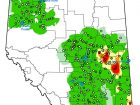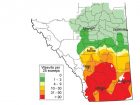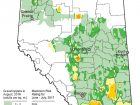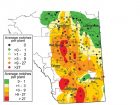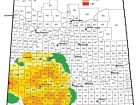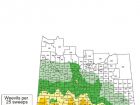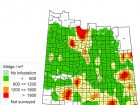
Features
Agronomy
Insect Pests
What may bug you in 2017
A dry spring hindered crop growth and gave a leg up to early season insects like cutworms and flea beetles in some areas of the Prairies in 2016. Mid-season growing conditions favoured wheat midge.
March 28, 2017 By Bruce Barker
Pests of all crops
Scott Hartley, provincial insect specialist with the Saskatchewan Ministry of Agriculture says cutworms became the main insect of concern in the last two weeks of May, with reports across Saskatchewan in most crops, including pea, lentil, wheat, oats, barley and canola. Due to favourable climatic conditions, cutworms developed faster than in previous, cooler springs. Damage was so extensive in some situations that crops were re-seeded.
In Manitoba and Alberta, cutworms were also problematic and continued to be at economic levels in many areas. Spraying and reseeding due to cutworm damage was reported in some areas across the Prairies.
“Get out and check your fields for cutworm. You have to scout for them,” says Scott Meers, provincial entomologist with Alberta Agriculture and Forestry.
Grasshoppers were generally a minor concern across the Prairies in 2016. However, the dry spring that persisted in some areas has set up the potential for localized outbreaks in 2017. The 2017 grasshopper forecast map for Alberta shows areas west of Lethbridge have the highest risk, and Meers says if the spring is dry in these areas, growers should be scouting fields.
The Saskatchewan and Manitoba 2017 grasshopper forecast maps show none to very light risk across most of the two provinces. The Alberta grasshopper forecast also calls for no risk to very light risk across most of the province.
John Gavloski, an entomologist with Manitoba Agriculture, says aphids started to appear on cereal crops in Manitoba in late-May and became quite noticeable in some fields as the season progressed, but few insecticides were applied. “High levels of natural enemies of aphids were noted in some fields,” he says.
Hartley says reports of aphids started in early to mid-July, first in lentil crops and soon followed by pea, wheat and canaryseed. Initially most reports were a result of regular field scouting and aphid numbers were not at economic threshold levels.
Canola pests
Flea beetle damage was low to moderate across the Prairies, as the use of seed treatments continues to be commonplace. Early seeded canola was more likely to have damage in 2016, as the crop grew slowly during the dry spring. In some cases, foliar insecticide application was required.
In southern Alberta, Meers says cabbage seedpod weevil is old news – and a regular occurrence. However, the pest continues to move northward. The 2016 Alberta survey now shows the pest has expanded beyond Red Deer to areas south of Edmonton.
In Saskatchewan, Hartley says distribution of the cabbage seedpod weevil now includes most of southern Saskatchewan to near the Manitoba border and north to Kindersley and Outlook in the west.
“If your field is the first to flower in an area with cabbage seedpod weevil, it has the highest risk,” Meers says. “If you farm south of Red Deer, scout as your canola comes into flower. It is easy to manage: scout, sweep and spray if above economic thresholds.”
Populations of bertha armyworm were generally low and uneconomical across the Prairies, with a few exceptions in the central part of Saskatchewan. All three provinces monitor the emergence of moths of bertha armyworm with pheromone-baited traps to provide a heads up if populations are building.
“This is a good system. It gives two to three weeks warning to get the word out and get insecticide and applicators lined up,” Meers says.
While swede midge has been identified in all three provinces, it has not reached economically damaging levels. Gavloski and Meers say no swede midge were captured in pheromone traps in 2016. In Saskatchewan, Agriculture and Agri-Food Canada (AAFC) Saskatoon reported swede midge emergence was about six to seven weeks earlier than in previous years due to higher temperatures in the spring. AAFC research continues on this pest to determine biology and potential management options. There were no reports of significant infestations in 2016.
High levels of lygus bug in canola were reported from the eastern, Interlake and central regions of Manitoba. [Click on images below to expand.]
Cereal pests
Humid conditions favoured wheat midge in eastern Saskatchewan, with very high numbers in many fields in 2016. The pest was not a concern in Alberta and Manitoba. For 2017, forecasts based on larval cocoons collected in fall soil samples in Alberta and Saskatchewan indicate a continued high risk of the pest in some areas. The wheat midge forecast maps show high risk where more than 1,200 larvae per square metre are indicated; infestations over 600 may still result in significant damage and yield loss if environmental conditions are favourable. Midge-tolerant varieties are available in red spring, durum and extra strong wheat classes and are used on an estimated one-third of Canada Western Red Spring wheat in Saskatchewan.
The wheat stem sawfly has had low populations since 2010, but base populations exist in a few locations in Alberta. The 2016 Alberta wheat stem sawfly survey shows a few hot spots, with the potential to develop into a problem in 2017 under dry spring conditions, including north of Lethbridge and north of Vauxhall.
Gavloski says armyworms were a concern and resulted in insecticide applications in some small grain fields in central and eastern Manitoba. Most of the insecticide applications for armyworms occurred in July. Some head clipping was noted in some fields in late July. There has been some control of armyworms in small grains in Manitoba every year since 2010.
Pulse pests
In Alberta, Meers says evidence of pea leaf weevil feeding in 2016 was present in a larger area than in 2015, expanding dramatically northward into central Alberta. Pea leaf weevil is now established from southern Alberta through west-central Alberta, as far north as Sturgeon County, north of Edmonton. In 2016, the most severe damage was in areas southeast and northwest of Lethbridge and in central Alberta between Highway 2 and Highway 21, from Calgary to north of Lacombe. For any producers south of Highway 9 and along Highway 2 up to Edmonton, there is a risk of damaging levels of pea leaf weevil in 2017, Meers warns.
“While this is not a strict forecast, experience has shown us that activity levels greater than nine notches per plant is sufficient to cause significant damage if conditions are favourable in the spring of 2017. This covers a large area of southern and west-central Alberta,” he says.
In Saskatchewan’s 2016 pea leaf weevil survey, and in additional reports, the pest has a much wider distribution to the east and north than previously known. The typical damage (notching) to the leaves of pea plants was noted southeast of Moose Jaw. Pea fields in the Outlook area had light levels of feeding, but fababean plots at the irrigation centre showed potentially economic levels of damage. There were also pea and fababean fields with high levels of feeding near Kyle and Davidson, and at fields around Saskatoon.
“Foliar application provides no yield benefit. If you are concerned, use a seed treatment and seed into warm soils so that the pea crop comes up quickly. The seed treatment provides only a certain window of protection, so if you are seeding early into cold soils, the clock is ticking and you may lose some of the insecticide control for when you really need it,” Meers says.
Pea aphid levels were above economic threshold in many Manitoba fields, and some pea fields in all areas were sprayed with insecticides. Pea aphids were also an issue in southern Alberta on lentil crops.
Forage pests
Feeding injury and high levels of alfalfa weevil larvae were common in many Manitoba alfalfa fields, Gavloski says. Some alfalfa for hay was cut early due to the presence of alfalfa weevil. Insecticides were applied in some fields and there were some reports they did not provide good control of alfalfa weevil. Meers says the pest is increasing in range and severity in southern Alberta, and resistance to the pyrethroid insecticide class has been reported at Brooks, Alta.
